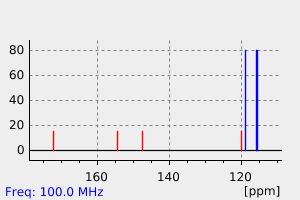2,5-二羟基苯甲酸酯 | 490-80-2
-
物化性质
-
计算性质
-
ADMET
-
安全信息
-
SDS
-
制备方法与用途
-
上下游信息
-
文献信息
-
表征谱图
-
同类化合物
-
相关功能分类
-
相关结构分类
物化性质
-
碰撞截面:124.6 Ų [M-H]- [CCS Type: DT, Method: single field calibrated with ESI Low Concentration Tuning Mix (Agilent)]
计算性质
-
辛醇/水分配系数(LogP):2.3
-
重原子数:11
-
可旋转键数:1
-
环数:1.0
-
sp3杂化的碳原子比例:0.0
-
拓扑面积:80.6
-
氢给体数:2
-
氢受体数:4
SDS
反应信息
-
作为反应物:描述:参考文献:名称:nag Genes of Ralstonia (Formerly Pseudomonas ) sp. Strain U2 Encoding Enzymes for Gentisate Catabolism摘要:摘要 Ralstonia 菌株 U2 通过庆大霉素将萘代谢为中心代谢产物。我们克隆并测序了一个 21.6 kb 的区域,该区域跨越了 nag 基因的 21.6-kb 区域。途径基因的上游是 nagY、 与趋化蛋白同源,以及 nagR、 是 LysR 家族的一个调控基因。与 nagR 与 nagR 分歧转录的基因是将萘转化为庆大霉素的基因 ( nagAaGHAbAcAdBFCQED )(S. L. Fuenmayor、M. Wild、A. L. Boyes 和 P. A. Williams,J. Bacteriol.180:2522-2530, 1998),其中除了插入了 nagGH 编码水杨酸 5-羟化酶的基因外,与萘转化为水杨酸的经典上途径操作子中的基因同源,且顺序相同。 假单胞菌 PpG7。在 nahD 的下游是一组基因( nagJIKLMN 可能与 nagAaGHAbAcAdBFCQED 作为一个单一的大操作子。通过克隆表达载体和生化试验,这些基因中有三个( nagIKL ) 编码参与将龙葵酯进一步分解为富马酸和丙酮酸的酶。NagI 是一种龙葵酯 1,2-二氧 化酶,能将龙葵酯转化为马来酰丙酮酸,还能催化某些取代的龙葵酯的氧化。NagL 是一种依赖还原型谷胱甘肽的马来酰丙酮酸异构酶,催化马来酰丙酮酸与富马酰丙酮酸的异构化。NagK 是富马酸丙酮酸水解酶,可将富马酸丙酮酸水解为富马酸和丙酮酸。其他三个基因( nagJMN )也已被克隆和过表达,但它们没有任何生化活性。NagJ 与谷胱甘肽 S -转移酶同源,NagM 和 NagN 与其他功能不明的蛋白质同源。操作子的下游是与转座酶同源的部分序列。DOI:10.1128/jb.183.2.700-708.2001
-
作为产物:描述:参考文献:名称:离子对内激发态质子耦合电子的转移摘要:使用光来驱动质子偶联电子转移(PCET)反应已引起越来越多的兴趣,最近集中在PCET反应(ES-PCET)中直接使用激发态。静电离子对提供了一种降低反应顺序的支架,并促进了电子转移化学中的许多发现。但是,它们的使用尚未转换为PCET。在本文中,我们表明,仅通过静电相互作用形成的离子对提供了研究ES-PCET机制的通用且简便的方法。这些离子对很容易在乙腈溶液中的水杨酸根阴离子与四阳离子钌络合物之间形成。在光激发后,通过离子对内水杨酸酯的ES-PCET氧化,发生了钌激发态的猝灭。瞬态吸收光谱法鉴定出还原的钌络合物和氧化的水杨酸盐自由基是该反应的主要光产物。由于离子配对而降低的反应阶数使得可以通过纳秒光致发光光谱法直接测量一阶PCET速率常数。这些PCET速率常数在较大的驱动力下达到饱和,这与接近Marcus无障碍区域一致。令人惊讶地,乙腈中存在水杨酸酯的质子转移互变异构体,质子位于羧酸酯官能团DOI:10.1039/c9sc04941j
文献信息
-
Flavoenzyme‐mediated Regioselective Aromatic Hydroxylation with Coenzyme Biomimetics作者:Alice Guarneri、Adrie H. Westphal、Jos Leertouwer、Joy Lunsonga、Maurice C. R. Franssen、Diederik J. Opperman、Frank Hollmann、Willem J. H. Berkel、Caroline E. PaulDOI:10.1002/cctc.201902044日期:2020.3.6selective aromatic hydroxylation with coenzyme biomimetics. The carbamoylmethyl‐substituted biomimetic in particular affords full conversion in less than two hours for the selective hydroxylation of 5 mM 3‐ and 4‐hydroxybenzoates, displaying similar rates as with NADH, achieving a 10 mM/h enzymatic conversion of the medicinal product gentisate. This biomimetic appears to generate less uncoupling of
-
Advanced oxidation processes for the removal of [bmim][Sal] third generation ionic liquids: effect of water matrices and intermediates identification作者:Nemanja Banić、Biljana Abramović、Filip Šibul、Dejan Orčić、Malcolm Watson、Milan Vraneš、Slobodan GadžurićDOI:10.1039/c6ra04416f日期:——organic compounds. Due to increased production and the high stability of these substances, they could be classified as persistent pollutants and could break through classical treatment systems into natural waters. A preliminary ionic liquid hydrolysis study demonstrated a pH dependent degradation profile with a significant decrease in hydrolysis efficiency as pH lowered from 10.0 to 2.8. In order to examine离子液体的独特性能使其成为常规挥发性有机化合物的绿色替代品。由于这些物质的增加产量和高度稳定性,它们可以被归类为持久性污染物,并且可以通过经典的处理系统进入天然水域。初步的离子液体水解研究表明,pH依赖性降解曲线会随着pH从10.0降低到2.8而显着降低水解效率。为了检查离子液体去除的未来前景,使用了不同的高级氧化工艺(TiO 2 Degussa P25 / H 2 O 2,TiO 2 Degussa P25、7.2Fe / TiO 2 / H 2 O 2和H 2研究了O 2)在咪唑基离子液体在水溶液中的降解中的适用性。这些过程是在黑暗中以及在存在UVA和模拟阳光(SS)辐射的情况下进行的。在研究的暗过程中,7.2Fe / TiO 2 / H 2 O 2系统显示出最高的效率,这可以归因于暗的非均质Fenton过程。否则,在所有研究的降解过程中,最有效的方法是UVA / TiO 2 Degussa
-
A Gene Cluster Encoding Steps in Conversion of Naphthalene to Gentisate in <i>Pseudomonas</i> sp. Strain U2作者:Sergio L. Fuenmayor、Mark Wild、Alastair L. Boyes、Peter A. WilliamsDOI:10.1128/jb.180.9.2522-2530.1998日期:1998.5
ABSTRACT Pseudomonas sp. strain U2 was isolated from oil-contaminated soil in Venezuela by selective enrichment on naphthalene as the sole carbon source. The genes for naphthalene dioxygenase were cloned from the plasmid DNA of strain U2 on an 8.3-kbBam HI fragment. The genes for the naphthalene dioxygenase genesnagAa (for ferredoxin reductase),nagAb (for ferredoxin), andnagAc andnagAd (for the large and small subunits of dioxygenase, respectively) were located by Southern hybridizations and by nucleotide sequencing. The genes fornagB (for naphthalenecis -dihydrodiol dehydrogenase) andnagF (for salicylaldehyde dehydrogenase) were inferred from subclones by their biochemical activities. BetweennagAa andnagAb were two open reading frames, homologs of which have also been identified in similar locations in two nitrotoluene-using strains (J. V. Parales, A. Kumar, R. E. Parales, and D. T. Gibson, Gene 181:57–61, 1996; W.-C. Suen, B. Haigler, and J. C. Spain, J. Bacteriol. 178:4926–4934, 1996) and a naphthalene-using strain (G. J. Zylstra, E. Kim, and A. K. Goyal, Genet. Eng. 19:257–269, 1997). RecombinantEscherichia coli strains with plasmids carrying this region were able to convert salicylate to gentisate, which was identified by a combination of gas chromatography-mass spectrometry and nuclear magnetic resonance. The first open reading frame, designatednagG , encodes a protein with characteristics of a Rieske-type iron-sulfur center homologous to the large subunits of dihydroxylating dioxygenases, and the second open reading frame, designatednagH , encodes a protein with limited homology to the small subunits of the same dioxygenases. Cloned together inE. coli ,nagG ,nagH , andnagAb , were able to convert salicylate (2-hydroxybenzoate) into gentisate (2,5-dihydroxybenzoate) and therefore encode a salicylate 5-hydroxylase activity. Single-gene knockouts ofnagG ,nagH , andnagAb demonstrated their functional roles in the formation of gentisate. It is proposed that NagG and NagH are structural subunits of salicylate 5-hydroxylase linked to an electron transport chain consisting of NagAb and NagAa, althoughE. coli appears to be able to partially substitute for the latter. This constitutes a novel mechanism for monohydroxylation of the aromatic ring. Salicylate hydroxylase and catechol 2,3-dioxygenase in strain U2 could not be detected either by enzyme assay or by Southern hybridization. However growth on both naphthalene and salicylate caused induction of gentisate 1,2-dioxygenase, confirming this route for salicylate catabolism in strain U2. Sequence comparisons suggest that the novel gene ordernagAa-nagG-nagH-nagAb-nagAc-nagAd-nagB-nagF represents the archetype for naphthalene strains which use the gentisate pathway rather than themeta cleavage pathway of catechol.摘要 假单胞菌 菌株 U2 是通过选择性富集萘作为唯一碳源从委内瑞拉受石油污染的土壤中分离出来的。从菌株 U2 的质粒 DNA 中克隆出了萘二氧合酶的基因,该基因被克隆在一个 8.3-kb Bam HI 片段。萘二氧化酶的基因为 nagAa (用于铁氧还原酶)、 nagAb (铁氧还原酶)和 nagAc 和 和 (分别代表二氧化酶的大亚基和小亚基)的基因。nagB nagB (的基因 顺 -二氢二醇脱氢酶)和 和 (水杨醛脱氢酶)是根据其生化活性从亚克隆中推断出来的。在 nagAa 和 nagAb 之间有两个开放阅读框,其同源物也已在两个使用硝基甲苯的菌株中的类似位置被发现(J. V. Parales、A. Kumar、R. E. Parales 和 D. T. Gibson,Gene 181:57-61,1996;W.-C.Suen、B. Haigler 和 J. C. Spain,J. Bacteriol.178:4926-4934, 1996)和一株使用萘的菌株(G. J. Zylstra, E. Kim, and A. K. Goyal, Genet.)重组 大肠杆菌 质粒的菌株能够将水杨酸盐转化为龙胆二酸盐,龙胆二酸盐是通过气相色谱-质谱联用仪和核磁共振鉴定出来的。第一个开放阅读框被命名为 nagG 编码的蛋白质具有与二羟化二氧酶大亚基同源的里斯克型铁硫中心的特征,第二个开放阅读框编码的蛋白质具有与二羟化二氧酶大亚基同源的里斯克型铁硫中心的特征,第二个开放阅读框编码的蛋白质具有与二羟化二氧酶大亚基同源的里斯克型铁硫中心的特征。 nagH 编码的蛋白质与同一种二氧合酶的小亚基具有有限的同源性。一起克隆到 大肠杆菌 , nagG , nagH 和 nagAb 能将水杨酸盐(2-羟基苯甲酸盐)转化为庆大霉素(2,5-二羟基苯甲酸盐),因此编码水杨酸盐 5-羟化酶活性。单基因敲除 nagG , nagH 和 nagAb 证明了它们在形成庆大霉素中的功能作用。据推测,NagG 和 NagH 是水杨酸 5-羟化酶的结构亚基,它们与由 NagAb 和 NagAa 组成的电子传递链相连接,不过,NagAb 和 NagAa 在水杨酸 5-羟化酶的形成过程中起着重要作用。 大肠杆菌 似乎能够部分替代后者。这构成了芳香环单羟化的新机制。无论是通过酶测定还是 Southern 杂交,都无法检测到菌株 U2 中的水杨酸羟化酶和儿茶酚 2,3- 二氧化酶。然而,萘和水杨酸的生长会诱导龙胆二酸 1,2-二加氧酶,这证实了水杨酸在菌株 U2 中的分解途径。序列比较表明,新基因顺序为 nagAa-nagG-nagH-nagAb-nagAc-nagAd-nagB-nagF 代表了萘菌株的原型,它们使用庆大霉素途径而不是 元 儿茶酚的裂解途径。 -
Immobilization of 3-hydroxybenzoate 6-hydroxylase onto functionalized electrospun polycaprolactone ultrafine fibers: A novel heterogeneous catalyst作者:Tiyaporn Srisook、Thammasit Vongsetskul、Jeerus Sucharitakul、Pimchai Chaiyen、Pramuan TangboriboonratDOI:10.1016/j.reactfunctpolym.2014.05.010日期:2014.9
-
3-Hydroxybenzoate 6-hydroxylase from Pseudomonas aeruginosa作者:Edye E. Groseclose、D.W. RibbonsDOI:10.1016/0006-291x(73)91228-x日期:1973.12
表征谱图
-
氢谱1HNMR
-
质谱MS
-
碳谱13CNMR
-
红外IR
-
拉曼Raman
-
峰位数据
-
峰位匹配
-
表征信息







